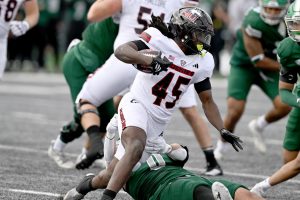Artifacts found in own backyard
November 18, 2004
You don’t need to head out to a taping of the “Antiques Roadshow” to catch historical artifacts: NIU has its own museum.
The NIU Anthropology Museum, located on the first floor in the Stevens Building, houses a variety of exhibits of donated artifacts.
“For such a small museum, we have a diverse collection,” graduate anthropology student Sarah Koepke said.
The museum, established in 1965, contains a mixed collection of ethnographic pieces and older artifacts from archeological digs. Ethnographic pieces are different from archeological artifacts in that they are pieces that document individual societies around the world.
“Almost everything is contemporary – from the 1900s or later,” said Ann Wright-Parsons, the director of the museum.
The section of the museum features an exhibit titled, “The Oldest Masters.” A cave built of Styrofoam and plaster leads to a hairy mannequin named George dressed in fur skins, crouched down drawing shapes and animals – representing caves in France, Spain and Africa.
“That exhibit with the guy [George] scares people in the back room,” said Judith Dawson, a senior business management major. “People want to touch it when they realize it’s not real.”
The “Mastodon” exhibit features mastodon bones found on a farm south of DeKalb, projectile points used by humans who lived when the mastodon did and a life-size mural of a mastodon.
Light-up dioramas in the “Skywatchers” exhibit feature miniatures of Stonehenge, a Mayan city and the Medicine Circle located in the Bighorn Mountains of Wyoming.
The second half of the museum is composed of donated pieces from Dr. Kenneth Honea, an associate professor of anthropology who died in March. Koepke has been working at the museum for a year and built the exhibit featuring Honea’s items.
“Putting together the Dr. Honea exhibit was interesting,” Koepke said. “He did so many different things in his life that it was hard to put disparate objects together and tell a story about him in one place.”
A stuffed Alaskan brown bear named Brenda crouches in a corner and sports a Cubs hat on the museum’s Web site. The bear was donated to NIU after another museum no longer had space for it.
Although only 150 pieces are displayed in the museum, the museum collection boasts about 6,000 ethnographic pieces and 150,000 archeological artifacts.
“If a pot found somewhere is broken into several pieces, each piece is counted as an artifact, so the count goes up pretty quickly,” Wright-Parsons said.
The remaining collection is stored in the basement of Cole Hall in temperature-controlled rooms with several dehumidifiers scattered along the floor to keep moisture from destroying the pieces. Preservation is key of the collection.
“For any exhibit that goes out, 90 percent of the time goes into research, proper care, techniques and cataloging,” Wright-Parsons said.
Pieces are arranged in storage cabinets by their area of origin. Glittering Thai masks, weathered Native American moccasins and intricately woven rugs from the Philippines are a few of the contemporary pieces collected from around the world.
Wright-Parsons’ favorite collection comes from the island of Kythnos in Greece.
“It’s not only the story of the professor who donated it, but it’s a story of the island as well,” Wright-Parsons said.
The Kythnos collection includes red hats worn by the men on the island, instruments for fishing and charms worn by children to ward off evil spirits.
Wright-Parsons and her staff are working on a collection of items from the Philippines donated from a doctor in Ohio who was stationed on the island in the ’70s. Books about the country, woven baskets and fabrics threaded from banana and pineapple plants are among some of the items that will be displayed. Students in the anthropology department lent a hand to catalog the collection.
“The doctor brought the collection in last Thursday a little while before one of my classes,” Wright-Parsons said. “My students documented the pieces then.”
Wright-Parsons calls the museum’s collection a hidden gem.
“I think students enjoy working with the collection and people are amazed at how many pieces are in it,” Wright-Parsons said.
The museum is open 9 a.m. to 5 p.m. Monday through Friday. Tours can be scheduled by calling 753-0230.






